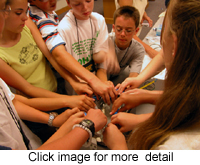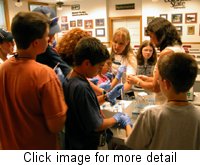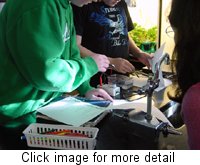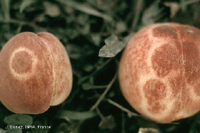Marie A. C. Langham
South Dakota State University
Are you wondering how to introduce your class to the molecular world of DNA and the techniques used to purify and characterize it? Do you need laboratory materials to introduce these techniques to your students and to relate them to common problems? Are you looking for experiments that can demonstrate complicated techniques in a straightforward manner? Then Classroom Activities in Plant Biotechnology could be exactly what you need.
|
 |
Developed by Drs. Jan Stephens and Jan Leach at Colorado State University as a part of the RiceCap Outreach Project (see box below), Classroom Activities in Plant Biotechnology is an educational website focused on the role of DNA in plants and plant diseases. The website introduces DNA by relating it to the foods we consume and how DNA sequences determine the proteins and other structures of the foods. It extends this discussion to the importance of food supplies and to plant diseases that threaten food production. The website looks at some common diseases, and features a section on the Irish Potato Famine. However, this source does not only include discussion. The website provides procedures for DNA extraction, gel electrophoresis of dyes, restriction enzyme analysis, and bacterial transformation with green fluorescent protein (GFP). These protocols are user friendly. For example, the DNA isolation protocol substitutes shampoo and table salt for more expensive commercial chemicals used in other procedures. The website also provides information and discussion questions on these procedures, plant diseases, the impacts of plant diseases on society, and their effects on human health.
|
 |
Classroom Activities in Plant Biotechnology is only one portion of the outreach program that Drs. Stephens and Leach are leading in Colorado. Training workshops for teachers and for students are also included in this project. For example, Dr. Stephens taught two groups of students (Figs. 1-3) in June from a program at Colorado State University that strives to maintain the interest of women and minorities in science and engineering. The students in the first group were from grades 6-8, and they extracted DNA from kiwi fruit and transformed E. coli with GFP. The second group contained students from grades 9-12. Over three days, this older group extracted DNA, ran gel electrophoresis, performed restriction digests, transformed E. coli, and established tissue cultures. Students in the training classes are tested prior to beginning and after finishing the classes to determine the variation in their entry level knowledge and to quantify their assimilation of knowledge during the course.
|

| |
Classroom Activities in Plant Biotechnology may be exactly what you need to add more information or laboratories about DNA to your classes. Take a look at all it has to offer you and your students!!!
|
The RiceCap program is a coordinated research, education, and extension project for applying genomic discoveries in improving rice in the US. As part of their objectives, they provide educational opportunities for students focusing on the potential of genomic research. It is supported by the USDA National Research Initiative Competitive Grants Program with funding from the USDA, Cooperative State Research, Education, and Extension Service (CSREES) in the area of Applied Plant Genomics Coordinated Agricultural Program (APG-CAP). |
 |
Views: You may be planning to tell your sweetheart that they are a real “peach” on Valentine, but be sure that it is not a peach infected with plum pox virus (PPV) (genus Potyvirus; family Potyviridae). Click image for an enlarged view and more information.
|
